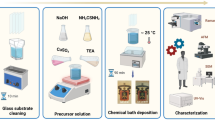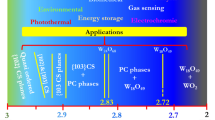Abstract
Silver antimony oxide (Ag2Sb2O6) having a defect pyrochlore structure has been synthesized by solid-state reaction between silver oxide and either Sb2O3 and Sb2O5. The reaction sequence has been shown by thermogravimetry, interdiffusion measurements on oxide pellets and electrical conductance measurements to involve the reduction of Ag2O, followed by diffusion of silver and oxygen into the antimony oxide component. When the starting material is Sb2O3, initial diffusion of oxygen occurs, forming Sb2O4 into which silver and further oxygen subsequently diffuse. Comparison of the activation energies for diffusion and electrical conductance in the various oxide phases suggests that the rate of Ag2Sb2O6 formation is controlled by the diffusion of oxygen rather than that of silver.
Résumé
L'oxyde d'argent antimonié (Ag2Sb2O6) à structure pyrochlore imparfaite a été synthétisé par réaction en phase solide entre l'oxyde d'argent et Sb2O3 ou Sb2O5. La séquence de réaction étudiée par thermogravimétrie, par mesures d'interdiffusion sur pastilles d'oxyde et par mesures de conductibilité électrique consiste en la réduction de Ag2O suivie par la diffusion de l'argent et de l'oxygène dans le composant d'oxyde antimonié. Quand le matériau de départ est Sb2O3, la diffusion initiale d'oxygène a lieu et donne Sb2O4 dans lequel l'argent et l'oxygène en excès diffusent ensuite. La comparaison des énergies d'activation pour la diffusion et la conductivité électrique dans les diverses phases d'oxydes suggère que la vitesse de formation de Ag2Sb2O6 est contrôlée par la diffusion de l'oxygène plutôt que par celle de l'argent.
Zusammenfassung
Silber-Antimonoxid (Ag2Sb2O6) von defekter Pyrochlorstruktur wurde durch eine Festphasenreaktion zwischen Silberoxid und entweder Sb2O3 oder Sb2O5 synthetisiert. Durch Thermogravimetrie, Interdiffusionsmessung an Oxidpillen, sowie elektrische Leitfähigkeitsmessungen wurde erwiesen, daß die Reaktionsfolge die Reduktion von Ag2O mit darauffolgender Diffusion des Silbers und Sauerstoffs in die Antimonoxidkomponente enthält. Bei Sb2O3 als Ausgangsmaterial erfolgt eine Diffusion des Sauerstoffs wodurch Sb2O4 entsteht, in welches dann Silber und weiterer Sauerstoff diffundiert. Der Vergleich der Aktivierungsenergien der Diffusion und der elektrischen Leitfähigkeit in den verschiedenen Oxidphasen läßt vermuten, daß die Bildungsgeschwindigkeit des Ag2Sb2O6 eher durch die Diffusion des Sauerstoffs als durch die des Silbers bedingt ist.
Резюме
Реакцией в твердом со стоянии окиси серебр а и трëх окиси или пятиок иси сурьмы был синтезирован ант имонат серебра (Ag2Sb2O6), обладающий нарушенн ой пирохлорной структурой. Последов ательность реакций и сследована с помощью термогравим етрии. Измерения интердифф узии и электропровод ности на гранулах окисей свид етельствуют о восстановлении окис и серебра, с последующ ей диффузией серебра и к ислорода на окись сурьмы. Когда исходны м материалом являетс я трëхокись сурьмы, первоначальн о происходит диффузия кислорода с образованием Sb2O4 и на к оторую в дальнейшем диффунди руют серебро и кислород. Ср авнение энергий акти ваций диффузии и электропр оводлости различных окисных фа з, наводят на мысль, что скорость образования Ag2Sb2O6 опред еляет ся скорее диффузией к ислорода, чем серебра.
Similar content being viewed by others
References
A. W. Sleight, Mat. Res. Bull., 4 (1969) 377.
C. N. R. Rao andG. V. Subba Rao, Phys. Status Solidi, Ser. A., 1 (1970) 597.
J. M. Longo, P. M. Raccah andJ. B. Goodenough, Mat. Res. Bull., 4 (1969) 191.
K. J. D. Mackenzie, Trans. J. Brit. Ceram. Soc., 77(1978)13.
N. Schrewelius, Z. Anorg. Allgem. Chem., 238 (1938) 241.
P. Kofstad, “Nonstoichiometry, Diffusion and Electrical Conductivity in Binary Metal Oxides”, Wiley-Interscience, New York, 1972, p. 70.
Author information
Authors and Affiliations
Additional information
We are grateful to Mr. M. Ahangarha for assistance with the diffusion experiments and to Mr. A. Nossoni for assistance with the thermogravimetric experiments.
Rights and permissions
About this article
Cite this article
MacKenzie, K.J.D., Golestani-Fard, F. Formation and electrical properties of silver antimony oxide. Journal of Thermal Analysis 15, 333–342 (1979). https://doi.org/10.1007/BF01903657
Received:
Issue Date:
DOI: https://doi.org/10.1007/BF01903657




